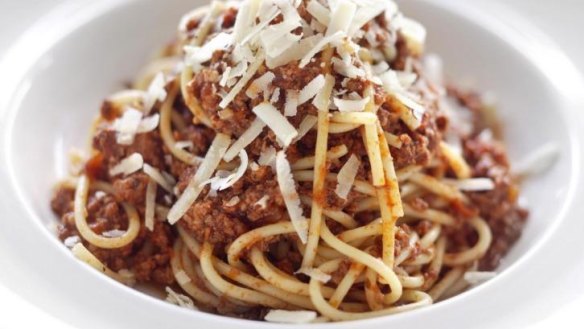How to avoid a runny batch of bolognese sauce

When I cook sauce for pasta bolognese for a large gathering and increase the recipe to feed 40 instead of 10, I find the sauce is much thinner and watery. S. Eynaud
So much of what we do in cooking is all about reduction of the water content and therefore concentration of flavour. You add onion, celery and carrot to a hot pan and you can see the water vapour curling up towards the rangehood. Together with the browned meat, tomatoes and a splash of wine, the cooking process softens the meat and veg but also boils away the water and you're left with the flavour compounds concentrated in less volume. If you suddenly quadruple the ingredients but not the size of the pot, there is only so much water that can boil away. The meat and veg will be soft but there is still a lot of water left in the mix. You will need to increase the size of your pot's diameter to give a greater surface area, or divide the cooking into different pots.
How do I slice corned beef from the slow cooker without it crumbling and falling apart? B. Partridge
There used to be restaurant in Melbourne's South Yarra called Lynch's. It was patronised by private-school-educated businessmen who dined on wonderful corned beef with mustard sauce. Corned beef is made with muscles from the back of a cow's thigh. It is very lean and formed by long, coarse fibres. This makes it cheap and chewy meat. Corning refers to what was once a process of preservation with "corns" of salt. Corned beef is slowly cooked in water, often with cloves and lemon, to soften the meat. In doing so, the long muscle fibres can come away from each other, resulting in stringy, crumbly meat. To avoid this, make sure you cut the beef with a very sharp knife, such as a bread knife with a scalloped edge. Rest the meat: all meat should be rested, even sausages. If you are serving the corned beef cold, try this trick. As soon as the beef is cool enough to handle, wrap it tightly in plastic film, allow to cool, then refrigerate. This will help keep the cooking juices that are laden with dissolved protein inside the meat. As the meat cools the protein turns into a thick gel that acts like glue. Slice the beef with the plastic film still on and then remove the plastic before serving.
I have a medical condition that makes me allergic to pork. I'm always trying to find alternatives in cooking. What can you suggest? V. Joubert
Oh god. I am so sorry. Nonetheless. I see from your letter that you have been substituting bresaola for prosciutto. Good. Hunt around for wagyu beef smallgoods. They contain that fine fat that has a similar mouthfeel to pork fat. Try moondarra.com.au. If a recipe calls for the addition of chorizo, add a teaspoon of bitter-sweet Spanish paprika to the recipe at the end of any frying-off method. If you want the smoky flavour of kaiserfleisch, there are some small producers of smoked beef "bacon", try wbgbeef.com.au. For other smallgoods check out the extensive kosher sections in eastern suburbs supermarkets. As far as bacon goes – there is no substitute for bacon.
Send your vexing culinary conundrums to brainfood@richardcornish.com.au or tweet to @FoodCornish
The best recipes from Australia's leading chefs straight to your inbox.
Sign up